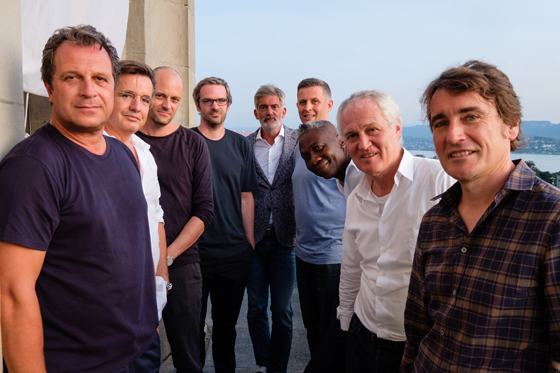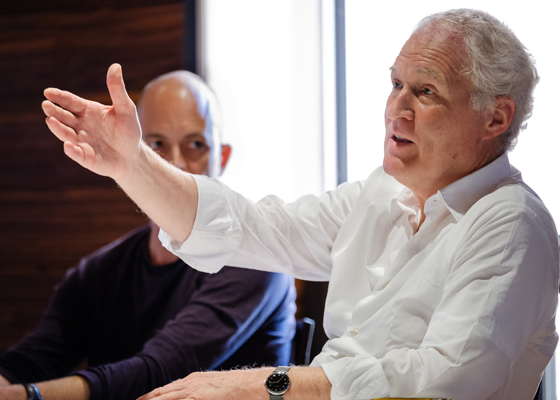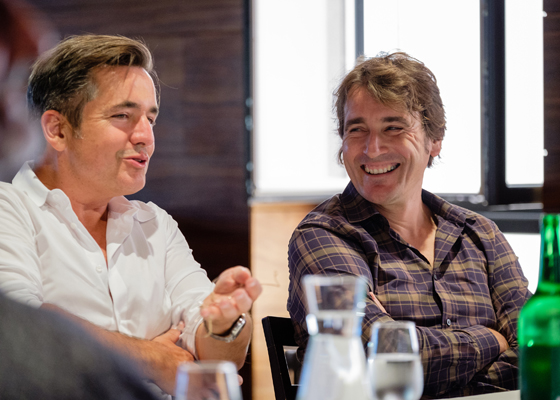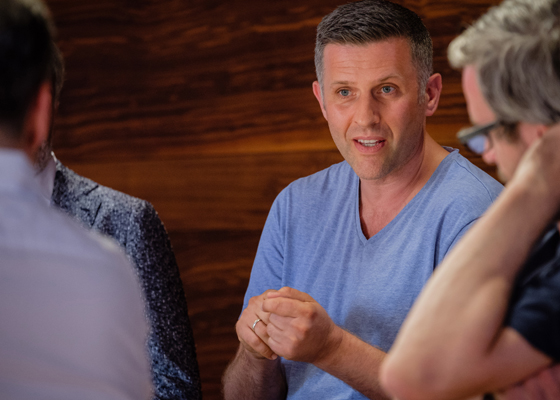Designers’ Talk at neue räume 17: Swiss Design Yesterday, Today and Tomorrow
Text by Neue Räume
Zurich, Switzerland
07.11.17
In the run-up to the neue räume 17 design exhibition that takes place from 15 to 19 November in Zurich, eight renowned Swiss designers came together for a constructive debate about current trends and future challenges of "Swiss Design".
The Landi chair by Hans Coray, the wooden chairs from Horgenglarus, the Rex peeler and the Swiss Army Knife from Victorinox: all these products represent Swiss design tradition. But, which qualities are common to Swiss design today? According to both stereotype and the critics, Swiss design is rational, reduced and economical in its use of materials. Is this still true for contemporary Swiss design? And where does the principle of good form come from? Eight designers tackled these questions and had a look at the current state of the Swiss design scene: Aurel Aebi (atelier oï.), Jörg Boner, Alfredo Häberli, Stephan Hürlemann, Charles O. Job, Moritz Schmid, This Weber and Stefan Zwicky all discussed both the DNA and versatility of Swiss design, as well as the possibilities afforded by digitisation and the meaning of analogue events such as trade fairs and exhibitions.
Taking place at the end of August and hosted by journalist HG Hildebrandt, the discussion focused on current and future influences and challenges, as well as on the question what it means to constantly have to reposition yourself between the poles of tradition and future.
Aurel Aebi, HG Hildebrandt, Stephan Hürlemann, Moritz Schmid, Alfredo Häberli, This Weber, Charles O. Job, Stefan Zwicky, Jörg Boner

Aurel Aebi, HG Hildebrandt, Stephan Hürlemann, Moritz Schmid, Alfredo Häberli, This Weber, Charles O. Job, Stefan Zwicky, Jörg Boner
×Swiss Design: An Attempt at a Definition
Is it still possible to talk about ‘typical Swiss design’ and what are the roots of the Swiss design tradition? The designers came up with very interesting and partly unexpected answers to these questions. “For me, Swiss design is, first and foremost, precision and a particular simplicity”, says Aurel Aebi. However, the discussants agreed that there were cultural differences between the country’s linguistic regions: “Different cultures come together in Switzerland: the German-speaking part, the Ticino and Romandie. Therefore, it is always difficult to solely focus on the German-speaking part of Switzerland”, says Aebi.
Jörg Boner took a similar view. Having come to appreciate in particular the approach of French designers during his time at the ECAL design school, he explains: “We always need a reason to do something. The French approach also allows for doing something without a reason, and I think that’s great! A beautiful line drawing can be reason enough for them.” He went on to state that there was a Germano-Swiss myth and that this myth would often be sold as the ‘Swiss thing’. “This is often about clichés, but, of course, there is also a bit of truth in every cliché”, says Boner.
Stefan Zwicky agrees: “Manufacturers from other countries love to collaborate with Swiss people as the Swiss tend to adhere to deadlines and are accurate and precise. This is still the case today.” Zwicky traced the roots of typical Swiss design back to the 1930s and 1940s and, predominantly, to the post-war era, to the oft-quoted ‘good form’, but he also observed a blending of national designs.
Host HG Hildebrandt (left) with Jörg Boner (right)
This Weber, who often collaborates with Italian manufacturers, is aware of the fact that the Swiss design tradition has had an influence on his work, but he does not consider it a defining one: “Many of my clients don’t even know I’m Swiss. Of course, I bring my Swiss ‘parcel’ to the table but surely nobody would commission me only because I’m Swiss.” For Weber, the most important qualities of a design are its proportions.
Moritz Schmid takes a similar view: “When I’m working, I don’t even think about whether it’s Swiss or not.” He brings back inspirations from each trip abroad but, as a Swiss designer, it’s also natural for him to refer to Swiss tradition and know-how. Nigeria-born architect and designer Charles O. Job recognises the achievements of Swiss design: “I’m the only one on this panel who’s not Swiss, and, before I came to Switzerland, I had no idea what Swiss design was. But when I got to know more about it, I was very, very fascinated and I quickly realised that it is mainly about inventiveness.”
Stephan Hürlemann, too, finds it difficult to define Swiss design: “Swiss clients and most Swiss designers today operate on an international level. I don’t think there is a formal label by which to define Swiss design. I have, however, many Swiss clients and I can see a somewhat conservative, rather reserved attitude.” He is convinced, however, that change is inevitable, also in design: “We are witnesses of our time and all of us are being influenced, in particular by the media. Whether it’s Japanese design or South American influences: everything we see, will, to a certain degree, have an effect on our designs and therefore eventually also on Swiss design.” Despite a growing internationalism in design, Alfredo Häberli, who was born in Argentina, can still see national differences, also with regard to interior design. “Different countries, different forms. The Scandinavians repaint their walls once a year, their interiors are altogether much more colourful. The French, Italian and Swiss are different again.”
Charles O. Job is impressed by Swiss inventiveness
Sustainability and Durability Continue to be Important in Design
In addition to inventiveness, innovation and precision, Swiss designers want their products to stand the test of time. Sustainability is not being limited to good quality and ecological materials. For Jörg Boner, the fundamental root of design is this: “What makes a designer is the will to create things whose form and meaning will stand the test of time. For me, too, this is a big incentive. Obviously, there are also times when you fail to achieve this goal. But it is actually the most exciting aspect of our work.” Stephan Hürlemann has observed that his clients tend to demand products that are aimed at particular stages in life. But, “the time during which children are a firm part of everyday life, for example, is comparatively short.” Designers often have to comply with the contexts in which their clients operate, although they would rather design furniture that can be used at all stages of life.
The current socio-demographic changes also pose new challenges for designers. In addition to products that, ideally, will be used over several stages of life, designers have to create meaningful alternatives, as This Weber puts it: “We have to provide options and we have to produce both inexpensive and expensive furniture.” For Alfredo Häberli, the biggest future challenge will be to deal with the growing cost pressure: “It is simply a fact that prices have come under immense pressure. To my mind, this is the biggest balancing act we have to master: to try and ensure that the quality of the products won’t be compromised.”
Alfredo Häberli talks about the increasing pressure to reduce production costs
The Internet as a Department Store, the Trade Fair as a Meeting Point
The designers are convinced that the digitisation of the interior furnishings industry is both a challenge and an opportunity. Says This Weber: “Young people, in particular, are absolutely fine with ordering a sofa on the Internet without testing it first. We will simply have to offer more and create great experiences if we want people to get up and leave the house to see our designs. The demands that are being placed on exhibition concepts are becoming increasingly more challenging.” Jörg Boner thinks “we have to develop a relaxed relationship with the digital.” According to Boner, the interlinking of the analogue and the digital world offers exciting new options: what’s wrong with testing a sofa in the showroom on a Saturday morning and ordering it online in the evening over a glass of red wine? “To give design a stage to talk about itself, we have been doing a consumer trade fair like neue räume for 16 years now”, says Stefan Zwicky.
Stephan Hürlemann adds: “The classic presentations are a unique opportunity for exhibitors to show their professionalism to specialist retailers and consumers and to build trust in their products.” For designer Charles O. Job, the focus is very much on simply being there and having first-hand experience: “ I always go to trade fairs. Of course, I also appreciate the digital side of things, I take a lot of photos and I’m on Facebook and Instagram. But to take the photos in the first place, you simply have to be there.” Interior design exhibitions are still popular not only as a source of inspiration for consumers, but they also play an important role as a meeting point for industry professionals. Direct customer feedback is priceless.
This Weber wants to design experiences to lure people out of the house
neue räume 17: A Special Look at Swiss Designers' Talk
As usual, the "neue räume 17" will attract trade visitors and end consumers with exciting special shows. This year, the results of the Designers' Talk will be staged in a multimedia
setting. All designers provided personal insights into their work, talked about sources of inspiration, about key moments and favourite objects. Selected works illustrate their values in terms of design and design.
Initiator and curator of neue räume, Stefan Zwicky, invited designers to join him for Designers’ Talk and designed the eponymous installation

Initiator and curator of neue räume, Stefan Zwicky, invited designers to join him for Designers’ Talk and designed the eponymous installation
×









